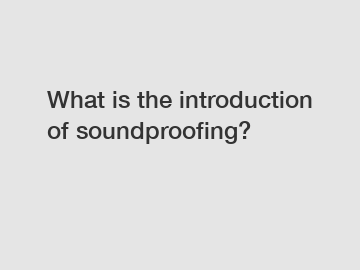Jan. 26, 2024
Energy
Soundproofing can be defined as the process of reducing or eliminating the transmission of sound between spaces. It involves making changes to the structure and materials of a room or building to impede sound waves from entering or escaping. The primary goal of soundproofing is to create a quieter and more comfortable environment, shielding us from the cacophony of the outside world.
Now, you might wonder why soundproofing is necessary in the first place. Well, research has shown that excessive noise can have severe consequences on our physical and mental health. Prolonged exposure to noise pollution can lead to stress, sleep disturbances, impaired concentration, and even cardiovascular disorders. Therefore, it becomes crucial to incorporate soundproofing measures into our living spaces to maintain a peaceful and healthy lifestyle.
The field of soundproofing has come a long way, thanks to advancements in technology and scientific research. There are various techniques available today, each designed to tackle different types of noise. Let's explore some of the most commonly used methods:

1. Insulation: Insulating materials such as foam, fiberboard, and mineral wool can be installed to absorb sound waves. These materials serve as a barrier, reducing the transfer of sound from one space to another.
2. Soundproof Windows: Windows are notorious for allowing external noise to infiltrate our homes. Soundproof windows are specially designed to minimize this problem by incorporating multiple layers of glass and insulating gases in between. They significantly reduce noise transmission and improve overall acoustic performance.
3. Acoustic Panels: These panels are made from dense materials that provide sound absorption. They can be attached to walls, ceilings, or doors to minimize echo and reverberation, thereby reducing overall noise levels.
4. Soundproofing Curtains: Specialized curtains made from heavy and dense fabric can be used to block out unwanted noise. These curtains are usually lined with sound-absorbing materials, ensuring a quieter and more peaceful environment.
In addition to these traditional methods, soundproofing has also adopted cutting-edge technologies to provide even better solutions. For instance, soundproofing companies now utilize innovative materials with enhanced acoustic properties, such as recycled rubber products or aerogel-based insulation. These advanced techniques not only improve sound insulation but also promote sustainability by utilizing eco-friendly materials.
Moreover, the concept of soundproofing has also extended beyond residential and commercial spaces. In recent years, there has been a rise in the demand for noise reduction in public spaces like airports, schools, and hospitals. Acoustic engineers and architects collaborate to develop innovative designs that reduce noise propagation and create more comfortable environments for the public.
It is important to note that soundproofing is not a one-size-fits-all solution. Every space has its unique noise challenges, from low-frequency vibrations to airborne sounds. Therefore, it is advisable to consult with professionals to assess the specific requirements of your environment and determine the most suitable soundproofing solution.
Are you interested in learning more about bipv solutions, solar tiles, BIPV? Contact us today to secure an expert consultation!
If you are interested in sending in a Guest Blogger Submission,welcome to write for us!
All Comments ( 0 )